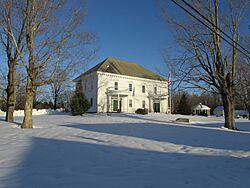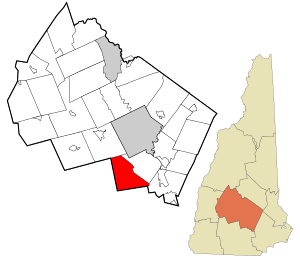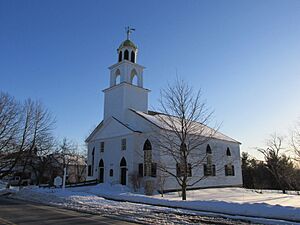Dunbarton, New Hampshire facts for kids
Quick facts for kids
Dunbarton, New Hampshire
|
|
|---|---|

Library and Town Hall
|
|

Location in Merrimack County and the state of New Hampshire
|
|
| Country | United States |
| State | New Hampshire |
| County | Merrimack |
| Incorporated | 1765 |
| Villages |
|
| Area | |
| • Total | 31.3 sq mi (81.1 km2) |
| • Land | 30.8 sq mi (79.9 km2) |
| • Water | 0.5 sq mi (1.2 km2) 1.48% |
| Elevation | 825 ft (251 m) |
| Population
(2020)
|
|
| • Total | 3,005 |
| • Density | 97/sq mi (37.6/km2) |
| Time zone | UTC-5 (Eastern) |
| • Summer (DST) | UTC-4 (Eastern) |
| ZIP code |
03046
|
| Area code(s) | 603 |
| FIPS code | 33-19460 |
| GNIS feature ID | 0873583 |
Dunbarton is a small and friendly town located in Merrimack County, New Hampshire, United States. It's a great place to learn about history and nature. In 2020, about 3,005 people lived here. This was a bit more than the 2,758 people who lived here in 2010.
Contents
History of Dunbarton
Dunbarton has an interesting past! It was first given out as land in 1735 and called "Gorham's-town." Later, in 1748, it was given out again and named "Starkstown."
Finally, in 1765, it officially became a town and was named Dunbarton. The name "Dunbarton" comes from a place called Dunbartonshire in Scotland. This was the hometown of Archibald Stark, who was an important early settler in the area.
Geography of Dunbarton
Dunbarton covers an area of about 81.1 square kilometers (about 31.3 square miles). Most of this land is dry, but about 1.2 square kilometers (0.5 square miles) is water. This means about 1.48% of the town is covered by water.
The town has several small rivers and streams. These include parts of the Turkey River and Black Brook. All the water in Dunbarton eventually flows into the Merrimack River.
The highest point in Dunbarton is about 925 feet (282 meters) above sea level. You can find this spot near NH Route 13, just north of Dunbarton Center.
Did you know? Some people believe Dunbarton is the exact middle point of all of New England! This idea came from a study done by Boston University in 2008.
Neighboring Towns
Dunbarton shares its borders with these other towns:
- Bow (to the northeast)
- Hooksett (to the east)
- Goffstown (to the south)
- Weare (to the west)
- Hopkinton (to the north)
Population Changes in Dunbarton
| Historical population | |||
|---|---|---|---|
| Census | Pop. | %± | |
| 1790 | 917 | — | |
| 1800 | 1,222 | 33.3% | |
| 1810 | 1,256 | 2.8% | |
| 1820 | 1,450 | 15.4% | |
| 1830 | 1,067 | −26.4% | |
| 1840 | 950 | −11.0% | |
| 1850 | 915 | −3.7% | |
| 1860 | 901 | −1.5% | |
| 1870 | 778 | −13.7% | |
| 1880 | 708 | −9.0% | |
| 1890 | 524 | −26.0% | |
| 1900 | 551 | 5.2% | |
| 1910 | 513 | −6.9% | |
| 1920 | 405 | −21.1% | |
| 1930 | 572 | 41.2% | |
| 1940 | 495 | −13.5% | |
| 1950 | 533 | 7.7% | |
| 1960 | 632 | 18.6% | |
| 1970 | 825 | 30.5% | |
| 1980 | 1,174 | 42.3% | |
| 1990 | 1,759 | 49.8% | |
| 2000 | 2,226 | 26.5% | |
| 2010 | 2,758 | 23.9% | |
| 2020 | 3,005 | 9.0% | |
| U.S. Decennial Census | |||
The number of people living in Dunbarton has changed a lot over the years. In 1790, there were 917 people. The population grew steadily for a while, reaching 1,450 people in 1820.
After that, the population went down for many years. By 1920, only 405 people lived in Dunbarton. But since then, the town has grown quite a bit! In 2020, the population reached 3,005 people. This shows that more and more families are choosing to live in Dunbarton.
Famous People from Dunbarton
Dunbarton has been home to some interesting and important people throughout history:
- Robert Lowell (1917–1977): He was a very famous poet. He is buried in Stark Cemetery in Dunbarton.
- John Ordway (1775–1817): John was a sergeant who helped lead the famous Lewis and Clark Expedition. This was a big journey to explore the western parts of the United States.
- Robert Rogers (1731–1795): He was a military commander. He led a group called Rogers' Rangers during the French and Indian War.
- Caleb Stark (1759–1838): Caleb was a New Hampshire state senator. He was the oldest son of General John Stark and Molly Stark.
- John Stark (1728–1822): John was a military officer from New Hampshire. He fought in the French and Indian War and was a major general in the Continental Army during the American Revolution. He is known as the "Hero of Bennington" for his bravery in a battle in 1777.
- Molly Stark (1737–1814): Molly was the wife of General John Stark. She became famous because of her husband's battle cry during the American Revolutionary War. She was a mother of 11 children and a strong supporter of her family and country.
See also
 In Spanish: Dunbarton (Nuevo Hampshire) para niños
In Spanish: Dunbarton (Nuevo Hampshire) para niños


